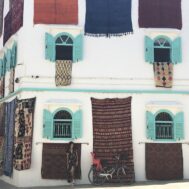France’s premier wine museum, La Cité du Vin, which presents the history and glories of wine-making, opened its first ‘Guest Wine Region’ temporary exhibition at the end of July with a tribute to Georgia, an ancient land nestled at the foot of the Caucasus Mountains.
Entitled Georgia, Cradle of Viticulture, the exhibit discusses the 8,000 year-old legacy of wine-making in Georgia, a legacy that is as innovative as it is intoxicating, and focuses on four key themes: The Roots of Georgian Wine Culture, Wine and Royalties, The Importance of Wine in Religious Beliefs and Wine in Everyday Life.
As the key themes highlight, wine-making in Georgian culture is intricately woven into the fabric of its history. There is evidence that viticulture grew along with the earliest agriculture among the inhabitants of the Caucasus Mountain region in the Neolithic era. Several thousand years later, the gold and bronze treasures of royalty were intricately decorated with images of grapevines and a wide variety of wine vessels appeared in noble tombs.
“Wine and vines” were depicted in all aspects of religious and secular life, both in pagan times and after the rise of Christianity. Saint Nino of Cappadocia (in present day Turkey) certainly struck a chord with his audience when, in the 4th century, he came to evangelize Georgia bringing a ‘Grapevine Cross’ made with vine branches. This same cross later became the symbol of the Georgian apostolic church.
Within single-family homes, wine cellars, called “marani”, were considered sacred places for the storage of the terracotta “Qvevri” used in the production and storage of wine. The traditional method of Georgian wine-making is included on the Representative List of the Intangible Cultural Heritage of Humanity. The method is described as a process of “pressing the grapes and then pouring the juice, grape skins, stalks and pips into the Qvevri, which is sealed and buried in the ground so that the wine can ferment for five to six months before being drunk.” This method of wine-making continues to this day and is considered an integral part of cultural and community life in Georgia.
The exhibition is co-organized and financed by the Georgian Ministry of Agriculture, through Mr Levan Davitashvili, Minister of Agriculture, and Ms. Ecaterine Siradze-Delaunay, the Georgian Ambassador to France. The project is supported by the National Wine Agency, the Georgian Wine Association, and the National Intellectual Property Center of Georgia («Sakpatenti»). The exhibition was designed by David Lordkipanidze, Managing Director at the Georgian National Museum, who also leads the ‘Research and Popularization of Georgian Grape and Wine Culture’ project
La Cité du Vin, on the banks of the Garonne River in the Bassins à Flot district of Bordeaux wine country, is itself as complex as a fine wine. It is often compared to theme parks such as Disneyland, but for adults, and themed around wine. La Cité du Vin was completed after seven years and took an estimated $91 million to build. The 10-story museum was constructed to resemble the swirl of wine as it is being poured into a decanter, and opened June 1, 2016.
La Cité du Vin’s permanent exhibit is entitled “The permanent tour: A voyage of discovery to the heart of wine cultures.” This exhibition emphasizes the culture of wine, wine-making and wine consuming in all its varied forms and is “in an open exhibition space occupying more than 3,000 m². Nearly twenty different themed areas invite you to take a voyage of discovery and enjoy a unique experience exploring the many and varied facets of wine across time and space.” Included in the experience is a “helicopter ride” over 20 wine-making regions in 17 different countries, a gallery of wine-themed paintings and pictures, a digital display of wine terroirs (the set of all environmental factors that affect a crop’s phenotype), depicting the subtle shifts in the interaction of the natural environment that produce the different characteristics of grapes, a “sea-voyage” along wine-trading routes, and many other areas devoted to the multi-complexity of wine culture.
La Cité du Vin’s first ‘Guest Wine Region’ temporary exhibition, Georgia, Cradle of Viticulture, through November 5, 2017.
 Cite du Vin, exhibit of ancient civilizations, Egyptian section, Courtesy Cite du Vin,
Cite du Vin, exhibit of ancient civilizations, Egyptian section, Courtesy Cite du Vin, 

